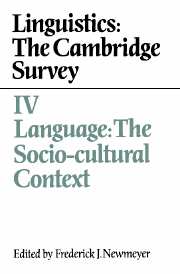Book contents
- Frontmatter
- Contents
- Contributors
- Preface
- 1 The study of language in its socio-cultural context
- 2 Language, culture, and world-view
- 3 Language and social class
- 4 Language and race: some implications for linguistic science
- 5 Language and gender
- 6 Bilingualism
- 7 Dialectology
- 8 Sociolinguistics and syntactic variation
- 9 Language birth: the processes of pidginization and creolization
- 10 Language death
- 11 Language planning: the view from linguistics
- 12 Ethnography of speaking: toward a linguistics of the praxis
- 13 The organization of discourse
- 14 Conversation analysis
- Index of names
- Index of subjects
- Contents of Volumes I, II, and III
9 - Language birth: the processes of pidginization and creolization
Published online by Cambridge University Press: 05 June 2012
- Frontmatter
- Contents
- Contributors
- Preface
- 1 The study of language in its socio-cultural context
- 2 Language, culture, and world-view
- 3 Language and social class
- 4 Language and race: some implications for linguistic science
- 5 Language and gender
- 6 Bilingualism
- 7 Dialectology
- 8 Sociolinguistics and syntactic variation
- 9 Language birth: the processes of pidginization and creolization
- 10 Language death
- 11 Language planning: the view from linguistics
- 12 Ethnography of speaking: toward a linguistics of the praxis
- 13 The organization of discourse
- 14 Conversation analysis
- Index of names
- Index of subjects
- Contents of Volumes I, II, and III
Summary
Introduction
Pidgins and creoles have been the center of linguistic controversy for over a century now (Coelho 1880–6; Schuchardt 1883, 1889, 1909) and give no indication of yielding that position today (Bickerton 1981, 1984). Many of the issues of a hundred years ago remain unresolved, and much of current discussion was anticipated by Schuchardt in his many articles. Even standard definitions of pidginization and creolization have not been accepted by all scholars concerned with the field (see, for example, the conflicting definitions in Hymes 1971 and Andersen 1983). For my purposes I will adopt the following definitions. A pidgin is a contract language which is an amalgam of linguistic elements of two or more languages and which arises in social and economic transactions between at least two groups speaking different languages, by a process of restriction and simplification of one of the languages of these groups, usually that in a socially superior position. This process of restriction and simplification is termed pidginization. By definition a pidgin is no one's native language. A creole is a pidgin which has become the native language of a speech community. In the process of becoming nativized, the pidgin undergoes extension and elaboration, i.e. it becomes creolized.
- Type
- Chapter
- Information
- Linguistics: The Cambridge Survey , pp. 162 - 183Publisher: Cambridge University PressPrint publication year: 1988
- 18
- Cited by



